HEALTH PROMOTION.
VerifiedAdded on 2022/11/26
|15
|3427
|7
AI Summary
assignment should include program logic model, program chronogram time table and program budget as mention in the assessment brief and also need to provide around 15 to 20 references. Tables and references are not included in the word count, so 2000 words can be accepted
Contribute Materials
Your contribution can guide someone’s learning journey. Share your
documents today.
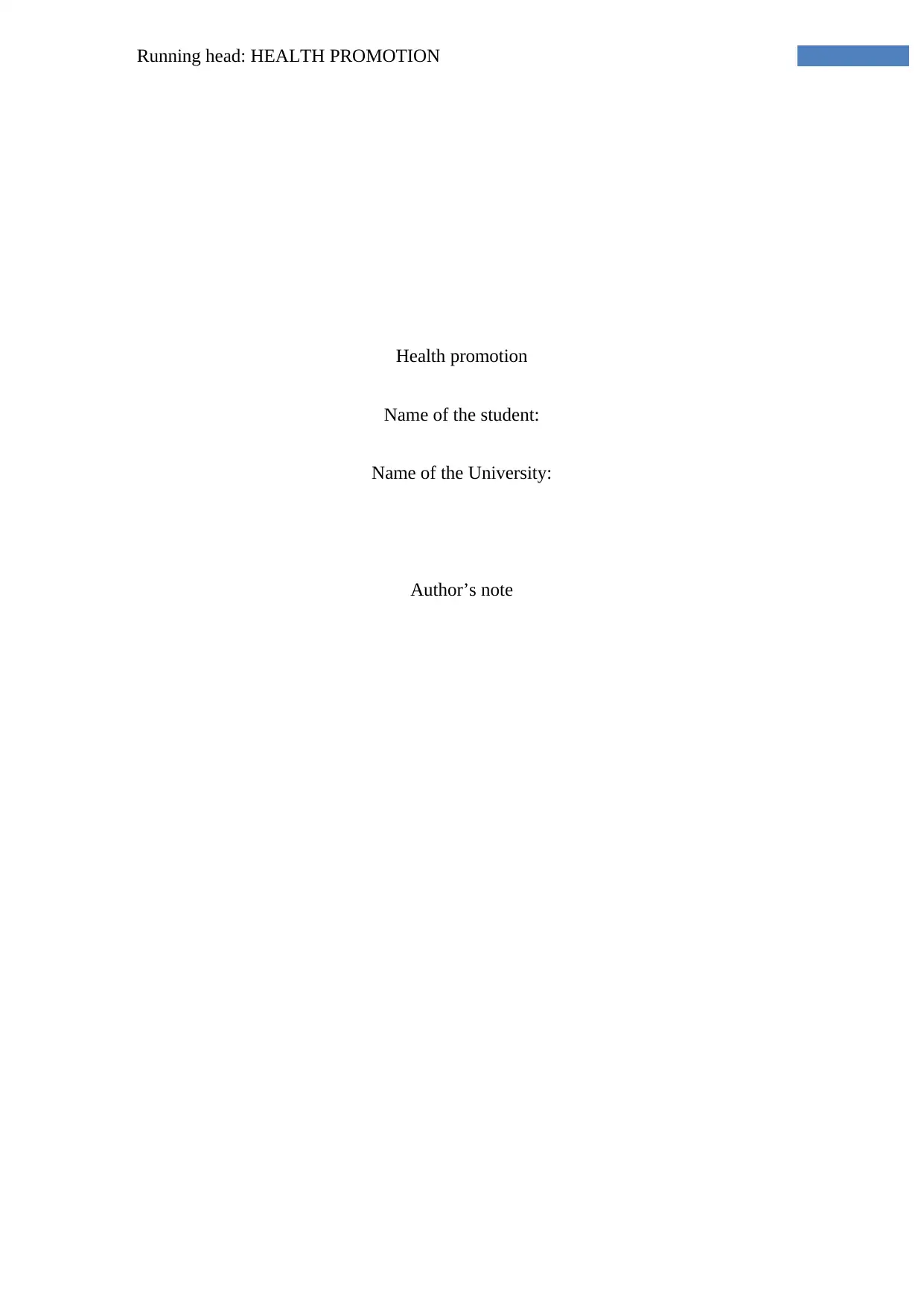
Running head: HEALTH PROMOTION
Health promotion
Name of the student:
Name of the University:
Author’s note
Health promotion
Name of the student:
Name of the University:
Author’s note
Secure Best Marks with AI Grader
Need help grading? Try our AI Grader for instant feedback on your assignments.
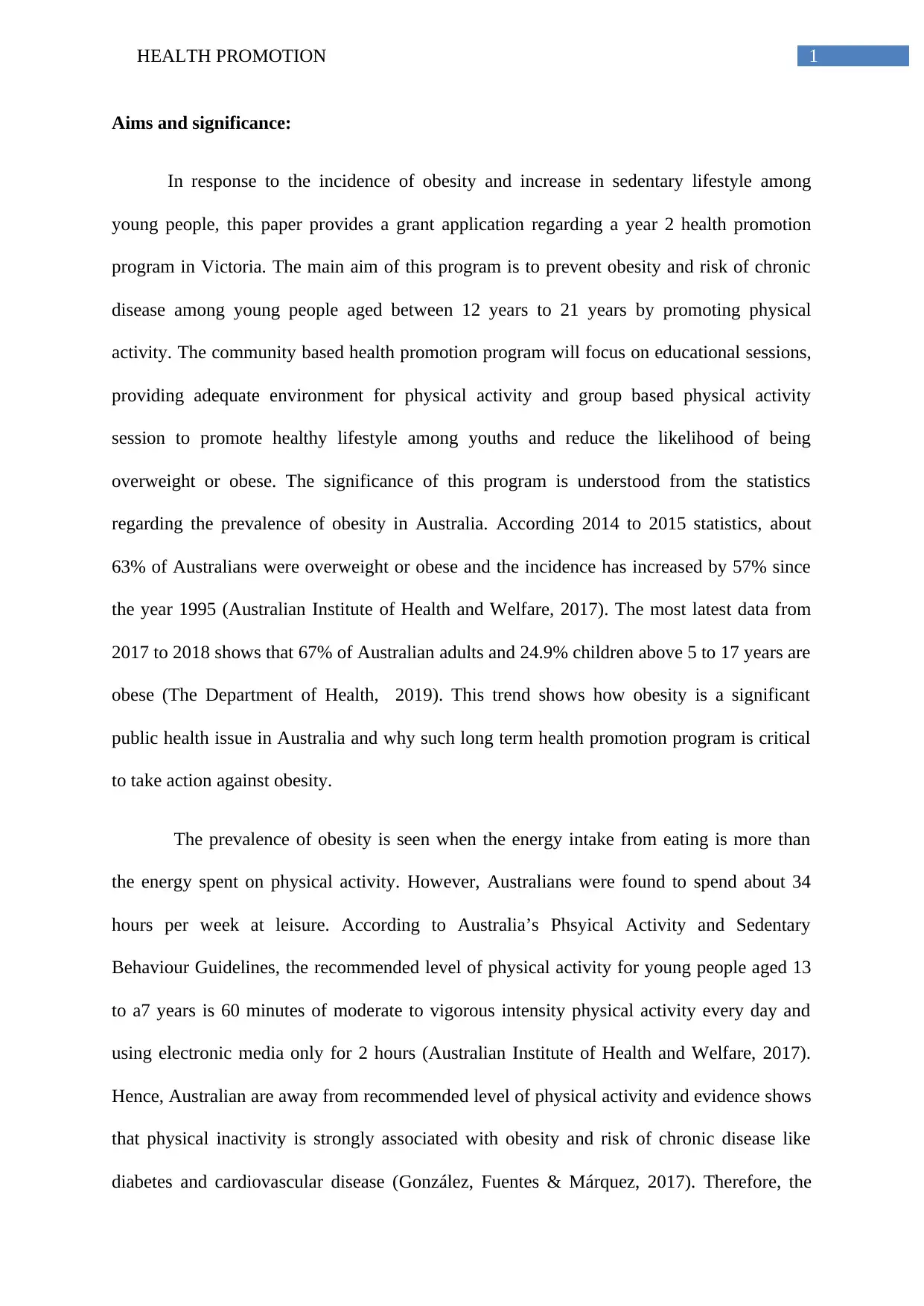
1HEALTH PROMOTION
Aims and significance:
In response to the incidence of obesity and increase in sedentary lifestyle among
young people, this paper provides a grant application regarding a year 2 health promotion
program in Victoria. The main aim of this program is to prevent obesity and risk of chronic
disease among young people aged between 12 years to 21 years by promoting physical
activity. The community based health promotion program will focus on educational sessions,
providing adequate environment for physical activity and group based physical activity
session to promote healthy lifestyle among youths and reduce the likelihood of being
overweight or obese. The significance of this program is understood from the statistics
regarding the prevalence of obesity in Australia. According 2014 to 2015 statistics, about
63% of Australians were overweight or obese and the incidence has increased by 57% since
the year 1995 (Australian Institute of Health and Welfare, 2017). The most latest data from
2017 to 2018 shows that 67% of Australian adults and 24.9% children above 5 to 17 years are
obese (The Department of Health, 2019). This trend shows how obesity is a significant
public health issue in Australia and why such long term health promotion program is critical
to take action against obesity.
The prevalence of obesity is seen when the energy intake from eating is more than
the energy spent on physical activity. However, Australians were found to spend about 34
hours per week at leisure. According to Australia’s Phsyical Activity and Sedentary
Behaviour Guidelines, the recommended level of physical activity for young people aged 13
to a7 years is 60 minutes of moderate to vigorous intensity physical activity every day and
using electronic media only for 2 hours (Australian Institute of Health and Welfare, 2017).
Hence, Australian are away from recommended level of physical activity and evidence shows
that physical inactivity is strongly associated with obesity and risk of chronic disease like
diabetes and cardiovascular disease (González, Fuentes & Márquez, 2017). Therefore, the
Aims and significance:
In response to the incidence of obesity and increase in sedentary lifestyle among
young people, this paper provides a grant application regarding a year 2 health promotion
program in Victoria. The main aim of this program is to prevent obesity and risk of chronic
disease among young people aged between 12 years to 21 years by promoting physical
activity. The community based health promotion program will focus on educational sessions,
providing adequate environment for physical activity and group based physical activity
session to promote healthy lifestyle among youths and reduce the likelihood of being
overweight or obese. The significance of this program is understood from the statistics
regarding the prevalence of obesity in Australia. According 2014 to 2015 statistics, about
63% of Australians were overweight or obese and the incidence has increased by 57% since
the year 1995 (Australian Institute of Health and Welfare, 2017). The most latest data from
2017 to 2018 shows that 67% of Australian adults and 24.9% children above 5 to 17 years are
obese (The Department of Health, 2019). This trend shows how obesity is a significant
public health issue in Australia and why such long term health promotion program is critical
to take action against obesity.
The prevalence of obesity is seen when the energy intake from eating is more than
the energy spent on physical activity. However, Australians were found to spend about 34
hours per week at leisure. According to Australia’s Phsyical Activity and Sedentary
Behaviour Guidelines, the recommended level of physical activity for young people aged 13
to a7 years is 60 minutes of moderate to vigorous intensity physical activity every day and
using electronic media only for 2 hours (Australian Institute of Health and Welfare, 2017).
Hence, Australian are away from recommended level of physical activity and evidence shows
that physical inactivity is strongly associated with obesity and risk of chronic disease like
diabetes and cardiovascular disease (González, Fuentes & Márquez, 2017). Therefore, the
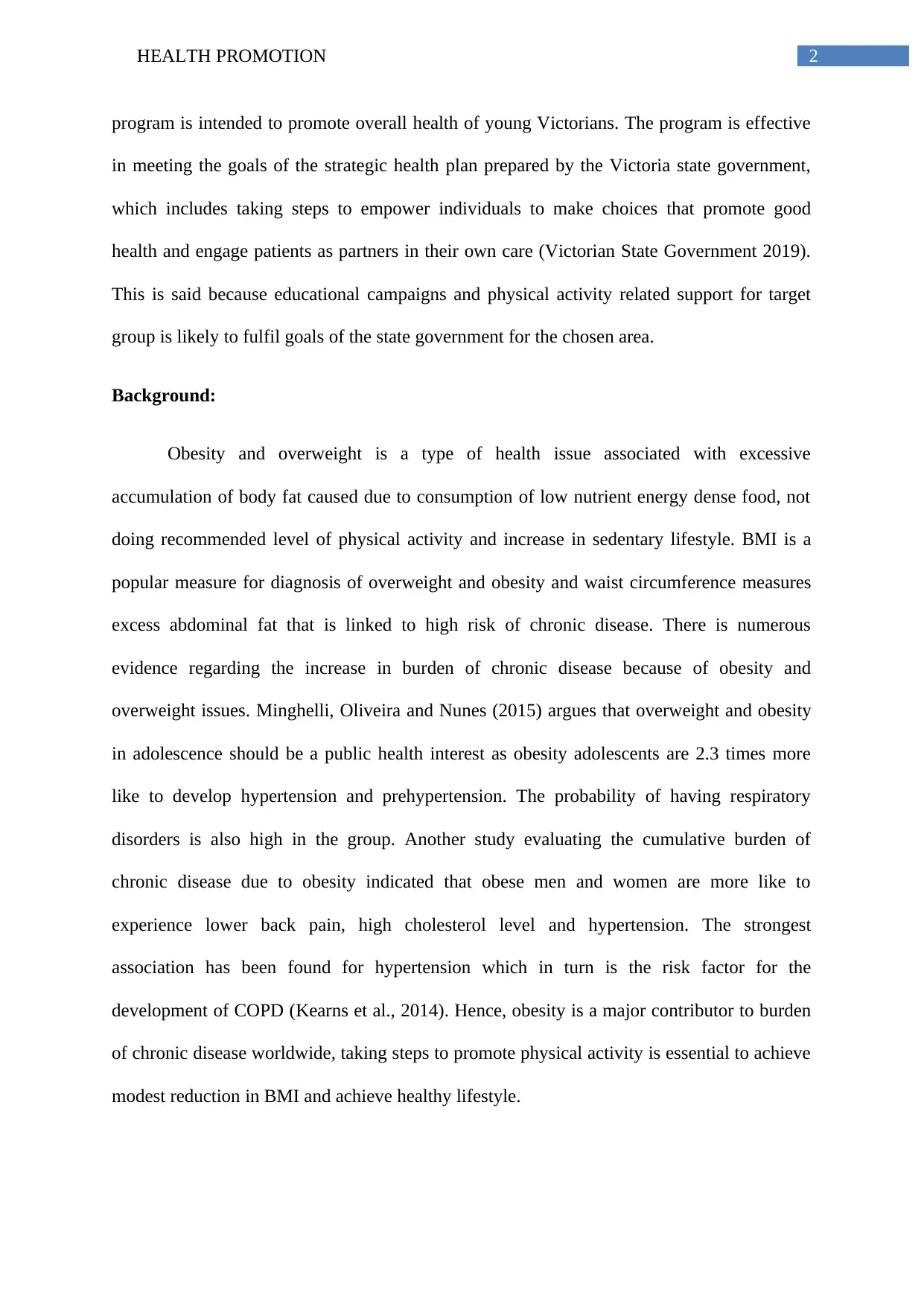
2HEALTH PROMOTION
program is intended to promote overall health of young Victorians. The program is effective
in meeting the goals of the strategic health plan prepared by the Victoria state government,
which includes taking steps to empower individuals to make choices that promote good
health and engage patients as partners in their own care (Victorian State Government 2019).
This is said because educational campaigns and physical activity related support for target
group is likely to fulfil goals of the state government for the chosen area.
Background:
Obesity and overweight is a type of health issue associated with excessive
accumulation of body fat caused due to consumption of low nutrient energy dense food, not
doing recommended level of physical activity and increase in sedentary lifestyle. BMI is a
popular measure for diagnosis of overweight and obesity and waist circumference measures
excess abdominal fat that is linked to high risk of chronic disease. There is numerous
evidence regarding the increase in burden of chronic disease because of obesity and
overweight issues. Minghelli, Oliveira and Nunes (2015) argues that overweight and obesity
in adolescence should be a public health interest as obesity adolescents are 2.3 times more
like to develop hypertension and prehypertension. The probability of having respiratory
disorders is also high in the group. Another study evaluating the cumulative burden of
chronic disease due to obesity indicated that obese men and women are more like to
experience lower back pain, high cholesterol level and hypertension. The strongest
association has been found for hypertension which in turn is the risk factor for the
development of COPD (Kearns et al., 2014). Hence, obesity is a major contributor to burden
of chronic disease worldwide, taking steps to promote physical activity is essential to achieve
modest reduction in BMI and achieve healthy lifestyle.
program is intended to promote overall health of young Victorians. The program is effective
in meeting the goals of the strategic health plan prepared by the Victoria state government,
which includes taking steps to empower individuals to make choices that promote good
health and engage patients as partners in their own care (Victorian State Government 2019).
This is said because educational campaigns and physical activity related support for target
group is likely to fulfil goals of the state government for the chosen area.
Background:
Obesity and overweight is a type of health issue associated with excessive
accumulation of body fat caused due to consumption of low nutrient energy dense food, not
doing recommended level of physical activity and increase in sedentary lifestyle. BMI is a
popular measure for diagnosis of overweight and obesity and waist circumference measures
excess abdominal fat that is linked to high risk of chronic disease. There is numerous
evidence regarding the increase in burden of chronic disease because of obesity and
overweight issues. Minghelli, Oliveira and Nunes (2015) argues that overweight and obesity
in adolescence should be a public health interest as obesity adolescents are 2.3 times more
like to develop hypertension and prehypertension. The probability of having respiratory
disorders is also high in the group. Another study evaluating the cumulative burden of
chronic disease due to obesity indicated that obese men and women are more like to
experience lower back pain, high cholesterol level and hypertension. The strongest
association has been found for hypertension which in turn is the risk factor for the
development of COPD (Kearns et al., 2014). Hence, obesity is a major contributor to burden
of chronic disease worldwide, taking steps to promote physical activity is essential to achieve
modest reduction in BMI and achieve healthy lifestyle.

3HEALTH PROMOTION
The two year health promotion targets young people for physical activity. The main
rationale behind this is increase in physical inactivity and burden of chronic disease in this
population group. Wijlaars, Gilbert and Hardelid (2016) opine that although infectious
disease is most commonly experience by children and young people. However, over the last
century, shift in burden of disease from infectious disease to chronic disease condition has
been seen. By the review of data linked to death certificate for children who died aged 1 to 18
years in UK, the study revealed that 57% of deaths occurred because of chronic conditions.
Although the study does not linked the burden of chronic disease with obesity, however there
are many evidence regarding the negative effects of sedentary behaviour and low physical
activity on health outcomes of people. For example, Pengpid and Peltzer (2019) revealed the
association between moderate physical activity and low sedentary time with anxiety and
depression. In addition, Barnett et al. (2018) particularly highlighted about the issue of
cardiometabolic health issue and obesity in moderns youths engaged in sedentary behaviours.
The deleterious effect of sedentary behaviour is seen because of screen based behaviour of
youths. Although tradition television viewing has declined, however use of screen based
devices like mobile phones and recreational content in youth has increased leading to overall
increase in screen time. Hence, this signifies the important of taking strategies to reduce
screen time and motivate youths to engage in activities that reduces risk of cardiometabolic
health issues.
The two year health promotion program focuses on reducing sedentary behaviour,
motivating youths to engage in physical activity and creating opportunities for physical
activity. There are evidence regarding implementation of many such physical activity based
programs and their benefits in reducing physical activity (PA) for youths. The study by Li et
al. (2014) gave the evidence regarding the implementation of a PA intervention in school.
The multi-component intervention was implemented in China and the main features of the
The two year health promotion targets young people for physical activity. The main
rationale behind this is increase in physical inactivity and burden of chronic disease in this
population group. Wijlaars, Gilbert and Hardelid (2016) opine that although infectious
disease is most commonly experience by children and young people. However, over the last
century, shift in burden of disease from infectious disease to chronic disease condition has
been seen. By the review of data linked to death certificate for children who died aged 1 to 18
years in UK, the study revealed that 57% of deaths occurred because of chronic conditions.
Although the study does not linked the burden of chronic disease with obesity, however there
are many evidence regarding the negative effects of sedentary behaviour and low physical
activity on health outcomes of people. For example, Pengpid and Peltzer (2019) revealed the
association between moderate physical activity and low sedentary time with anxiety and
depression. In addition, Barnett et al. (2018) particularly highlighted about the issue of
cardiometabolic health issue and obesity in moderns youths engaged in sedentary behaviours.
The deleterious effect of sedentary behaviour is seen because of screen based behaviour of
youths. Although tradition television viewing has declined, however use of screen based
devices like mobile phones and recreational content in youth has increased leading to overall
increase in screen time. Hence, this signifies the important of taking strategies to reduce
screen time and motivate youths to engage in activities that reduces risk of cardiometabolic
health issues.
The two year health promotion program focuses on reducing sedentary behaviour,
motivating youths to engage in physical activity and creating opportunities for physical
activity. There are evidence regarding implementation of many such physical activity based
programs and their benefits in reducing physical activity (PA) for youths. The study by Li et
al. (2014) gave the evidence regarding the implementation of a PA intervention in school.
The multi-component intervention was implemented in China and the main features of the
Secure Best Marks with AI Grader
Need help grading? Try our AI Grader for instant feedback on your assignments.
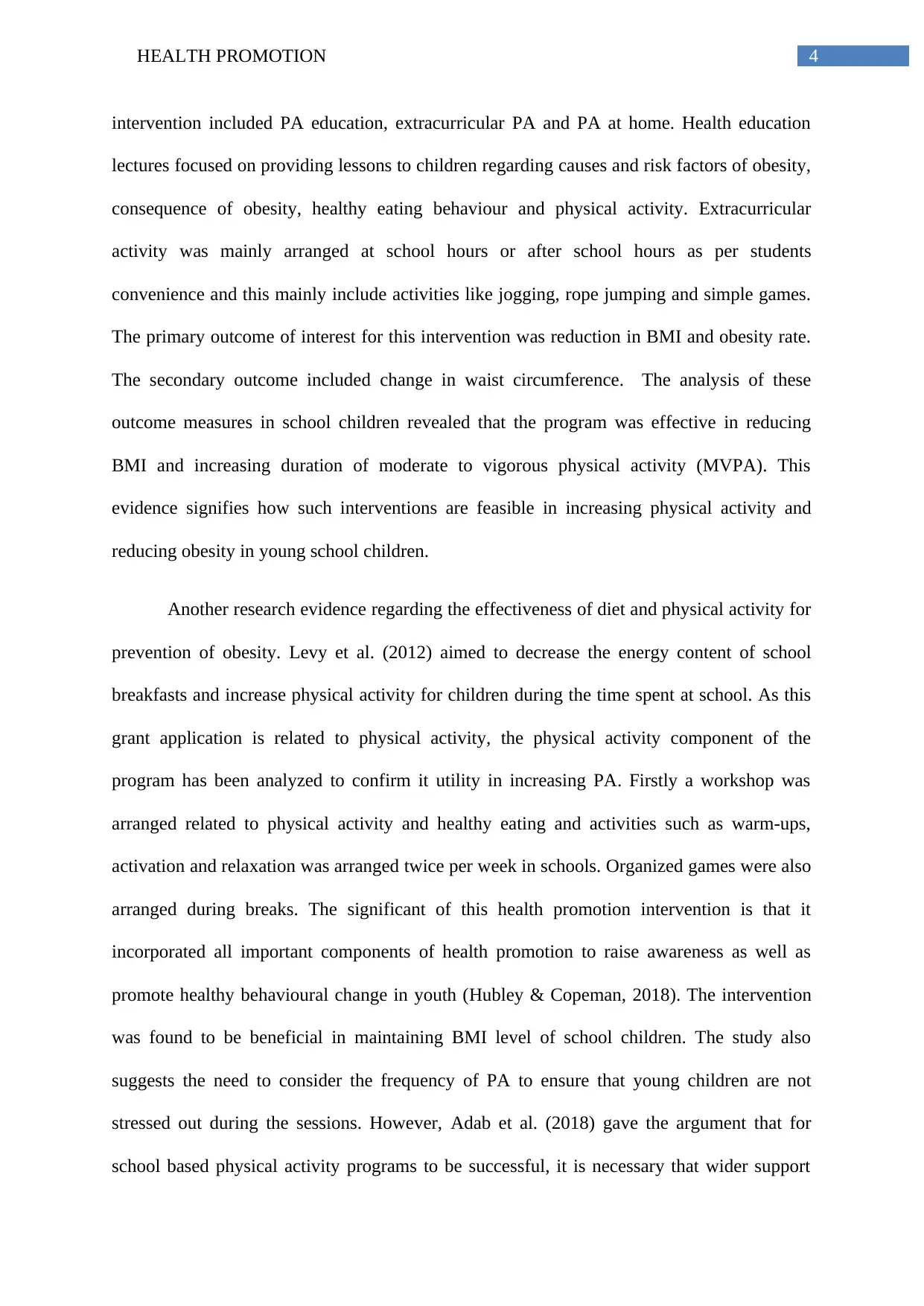
4HEALTH PROMOTION
intervention included PA education, extracurricular PA and PA at home. Health education
lectures focused on providing lessons to children regarding causes and risk factors of obesity,
consequence of obesity, healthy eating behaviour and physical activity. Extracurricular
activity was mainly arranged at school hours or after school hours as per students
convenience and this mainly include activities like jogging, rope jumping and simple games.
The primary outcome of interest for this intervention was reduction in BMI and obesity rate.
The secondary outcome included change in waist circumference. The analysis of these
outcome measures in school children revealed that the program was effective in reducing
BMI and increasing duration of moderate to vigorous physical activity (MVPA). This
evidence signifies how such interventions are feasible in increasing physical activity and
reducing obesity in young school children.
Another research evidence regarding the effectiveness of diet and physical activity for
prevention of obesity. Levy et al. (2012) aimed to decrease the energy content of school
breakfasts and increase physical activity for children during the time spent at school. As this
grant application is related to physical activity, the physical activity component of the
program has been analyzed to confirm it utility in increasing PA. Firstly a workshop was
arranged related to physical activity and healthy eating and activities such as warm-ups,
activation and relaxation was arranged twice per week in schools. Organized games were also
arranged during breaks. The significant of this health promotion intervention is that it
incorporated all important components of health promotion to raise awareness as well as
promote healthy behavioural change in youth (Hubley & Copeman, 2018). The intervention
was found to be beneficial in maintaining BMI level of school children. The study also
suggests the need to consider the frequency of PA to ensure that young children are not
stressed out during the sessions. However, Adab et al. (2018) gave the argument that for
school based physical activity programs to be successful, it is necessary that wider support
intervention included PA education, extracurricular PA and PA at home. Health education
lectures focused on providing lessons to children regarding causes and risk factors of obesity,
consequence of obesity, healthy eating behaviour and physical activity. Extracurricular
activity was mainly arranged at school hours or after school hours as per students
convenience and this mainly include activities like jogging, rope jumping and simple games.
The primary outcome of interest for this intervention was reduction in BMI and obesity rate.
The secondary outcome included change in waist circumference. The analysis of these
outcome measures in school children revealed that the program was effective in reducing
BMI and increasing duration of moderate to vigorous physical activity (MVPA). This
evidence signifies how such interventions are feasible in increasing physical activity and
reducing obesity in young school children.
Another research evidence regarding the effectiveness of diet and physical activity for
prevention of obesity. Levy et al. (2012) aimed to decrease the energy content of school
breakfasts and increase physical activity for children during the time spent at school. As this
grant application is related to physical activity, the physical activity component of the
program has been analyzed to confirm it utility in increasing PA. Firstly a workshop was
arranged related to physical activity and healthy eating and activities such as warm-ups,
activation and relaxation was arranged twice per week in schools. Organized games were also
arranged during breaks. The significant of this health promotion intervention is that it
incorporated all important components of health promotion to raise awareness as well as
promote healthy behavioural change in youth (Hubley & Copeman, 2018). The intervention
was found to be beneficial in maintaining BMI level of school children. The study also
suggests the need to consider the frequency of PA to ensure that young children are not
stressed out during the sessions. However, Adab et al. (2018) gave the argument that for
school based physical activity programs to be successful, it is necessary that wider support
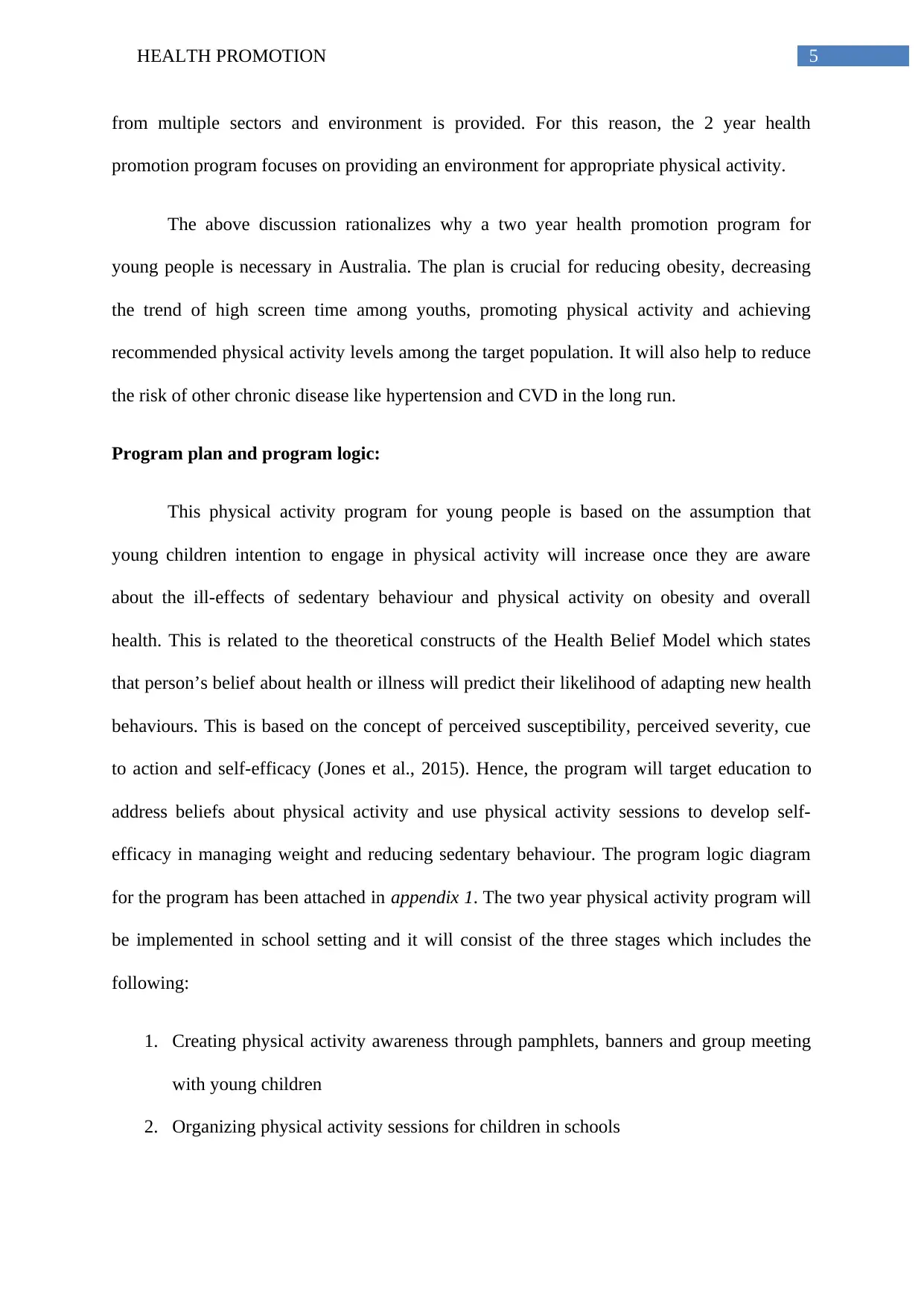
5HEALTH PROMOTION
from multiple sectors and environment is provided. For this reason, the 2 year health
promotion program focuses on providing an environment for appropriate physical activity.
The above discussion rationalizes why a two year health promotion program for
young people is necessary in Australia. The plan is crucial for reducing obesity, decreasing
the trend of high screen time among youths, promoting physical activity and achieving
recommended physical activity levels among the target population. It will also help to reduce
the risk of other chronic disease like hypertension and CVD in the long run.
Program plan and program logic:
This physical activity program for young people is based on the assumption that
young children intention to engage in physical activity will increase once they are aware
about the ill-effects of sedentary behaviour and physical activity on obesity and overall
health. This is related to the theoretical constructs of the Health Belief Model which states
that person’s belief about health or illness will predict their likelihood of adapting new health
behaviours. This is based on the concept of perceived susceptibility, perceived severity, cue
to action and self-efficacy (Jones et al., 2015). Hence, the program will target education to
address beliefs about physical activity and use physical activity sessions to develop self-
efficacy in managing weight and reducing sedentary behaviour. The program logic diagram
for the program has been attached in appendix 1. The two year physical activity program will
be implemented in school setting and it will consist of the three stages which includes the
following:
1. Creating physical activity awareness through pamphlets, banners and group meeting
with young children
2. Organizing physical activity sessions for children in schools
from multiple sectors and environment is provided. For this reason, the 2 year health
promotion program focuses on providing an environment for appropriate physical activity.
The above discussion rationalizes why a two year health promotion program for
young people is necessary in Australia. The plan is crucial for reducing obesity, decreasing
the trend of high screen time among youths, promoting physical activity and achieving
recommended physical activity levels among the target population. It will also help to reduce
the risk of other chronic disease like hypertension and CVD in the long run.
Program plan and program logic:
This physical activity program for young people is based on the assumption that
young children intention to engage in physical activity will increase once they are aware
about the ill-effects of sedentary behaviour and physical activity on obesity and overall
health. This is related to the theoretical constructs of the Health Belief Model which states
that person’s belief about health or illness will predict their likelihood of adapting new health
behaviours. This is based on the concept of perceived susceptibility, perceived severity, cue
to action and self-efficacy (Jones et al., 2015). Hence, the program will target education to
address beliefs about physical activity and use physical activity sessions to develop self-
efficacy in managing weight and reducing sedentary behaviour. The program logic diagram
for the program has been attached in appendix 1. The two year physical activity program will
be implemented in school setting and it will consist of the three stages which includes the
following:
1. Creating physical activity awareness through pamphlets, banners and group meeting
with young children
2. Organizing physical activity sessions for children in schools
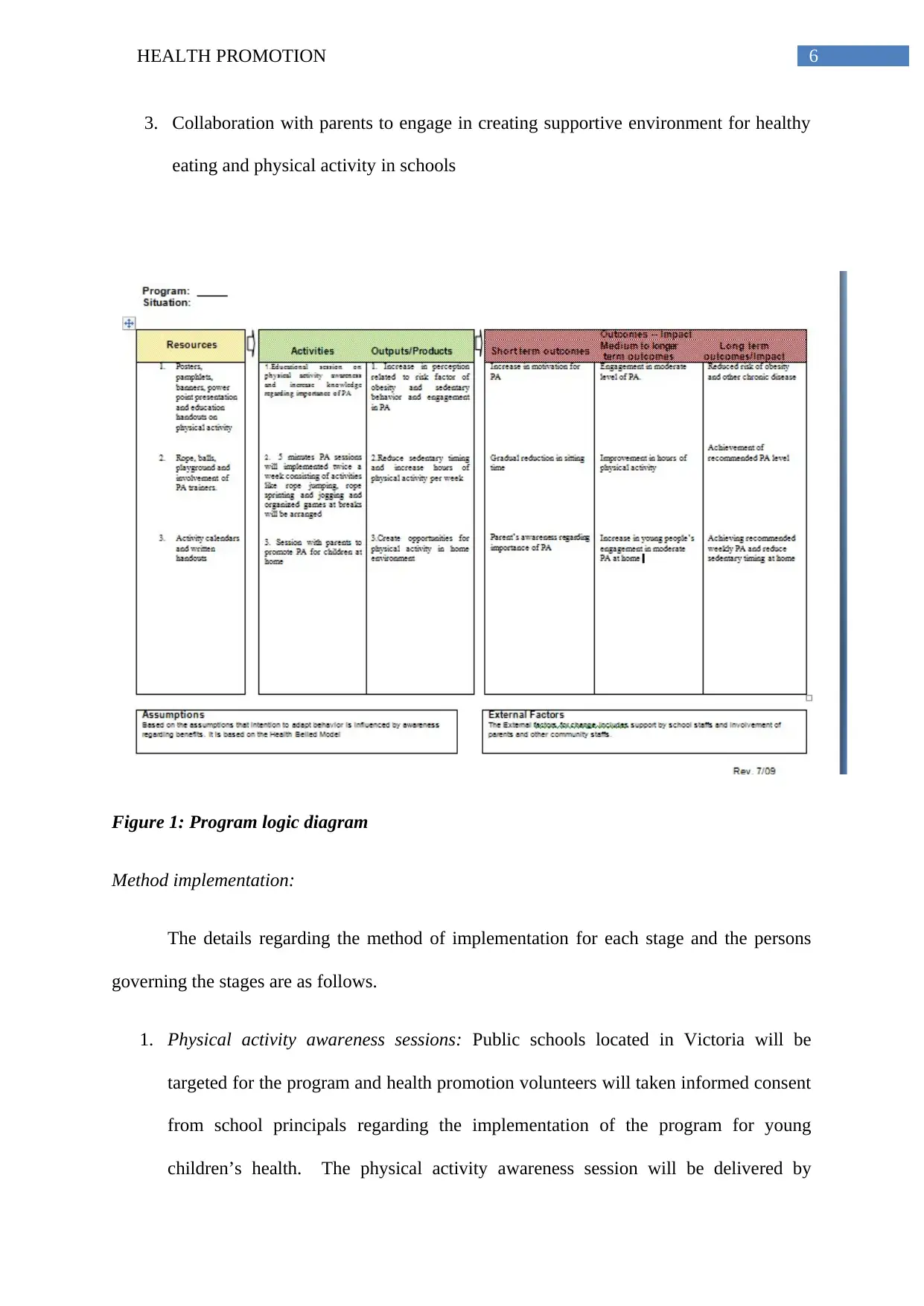
6HEALTH PROMOTION
3. Collaboration with parents to engage in creating supportive environment for healthy
eating and physical activity in schools
Figure 1: Program logic diagram
Method implementation:
The details regarding the method of implementation for each stage and the persons
governing the stages are as follows.
1. Physical activity awareness sessions: Public schools located in Victoria will be
targeted for the program and health promotion volunteers will taken informed consent
from school principals regarding the implementation of the program for young
children’s health. The physical activity awareness session will be delivered by
3. Collaboration with parents to engage in creating supportive environment for healthy
eating and physical activity in schools
Figure 1: Program logic diagram
Method implementation:
The details regarding the method of implementation for each stage and the persons
governing the stages are as follows.
1. Physical activity awareness sessions: Public schools located in Victoria will be
targeted for the program and health promotion volunteers will taken informed consent
from school principals regarding the implementation of the program for young
children’s health. The physical activity awareness session will be delivered by
Paraphrase This Document
Need a fresh take? Get an instant paraphrase of this document with our AI Paraphraser

7HEALTH PROMOTION
professionals who are experienced in health promotion activities. Social workers will
also be involved. The total duration for the session will be 2 months and the process
will start first by distributing pamphlets and posters in school premise. The pamphlet
will inform student and parents about purpose and content of the educational sessions.
The posters will be displayed in assembly halls and playground. This will be followed
by six educational sessions on cause and risk factors of obesity, importance of PA,
recommended PA levels and proper food choices. The education session will be
delivered by health promotion staffs in classes every week. The workshop intends to
expand knowledge regarding PA and also convey the message to teachers regarding
reducing sitting time and increasing activity levels of young children. Power point
presentations and handouts will be used as the resource to complete the education
workshop.
2. Physical activity sessions: The second phase of the intervention will be started in the
fourth month of the program and activities during this session will be governed by
physical activity trainers for each class. This stage of the program will target
improving PA levels in children, implementing extracurricular activities related to PA
and sustaining the new behaviour change. 45 minutes PA sessions will implemented
twice a week and in this period, children will be encouraged to take part in activities
like rope jumping, rope sprinting, jogging, active games and aerobics. The types of
games and activities will be changed after every two weeks. During the sessions, the
feedback will be taken from children regarding the experience of participating in the
session and any experience of fatigue. The duration of activity will be modified based
on this feedback. During this session, children will also encouraged to engage in some
PA at home for at least 20 minutes. The PA trainers will provided suggestions
regarding ways to stay active at home and maintain diary regarding hours of
professionals who are experienced in health promotion activities. Social workers will
also be involved. The total duration for the session will be 2 months and the process
will start first by distributing pamphlets and posters in school premise. The pamphlet
will inform student and parents about purpose and content of the educational sessions.
The posters will be displayed in assembly halls and playground. This will be followed
by six educational sessions on cause and risk factors of obesity, importance of PA,
recommended PA levels and proper food choices. The education session will be
delivered by health promotion staffs in classes every week. The workshop intends to
expand knowledge regarding PA and also convey the message to teachers regarding
reducing sitting time and increasing activity levels of young children. Power point
presentations and handouts will be used as the resource to complete the education
workshop.
2. Physical activity sessions: The second phase of the intervention will be started in the
fourth month of the program and activities during this session will be governed by
physical activity trainers for each class. This stage of the program will target
improving PA levels in children, implementing extracurricular activities related to PA
and sustaining the new behaviour change. 45 minutes PA sessions will implemented
twice a week and in this period, children will be encouraged to take part in activities
like rope jumping, rope sprinting, jogging, active games and aerobics. The types of
games and activities will be changed after every two weeks. During the sessions, the
feedback will be taken from children regarding the experience of participating in the
session and any experience of fatigue. The duration of activity will be modified based
on this feedback. During this session, children will also encouraged to engage in some
PA at home for at least 20 minutes. The PA trainers will provided suggestions
regarding ways to stay active at home and maintain diary regarding hours of
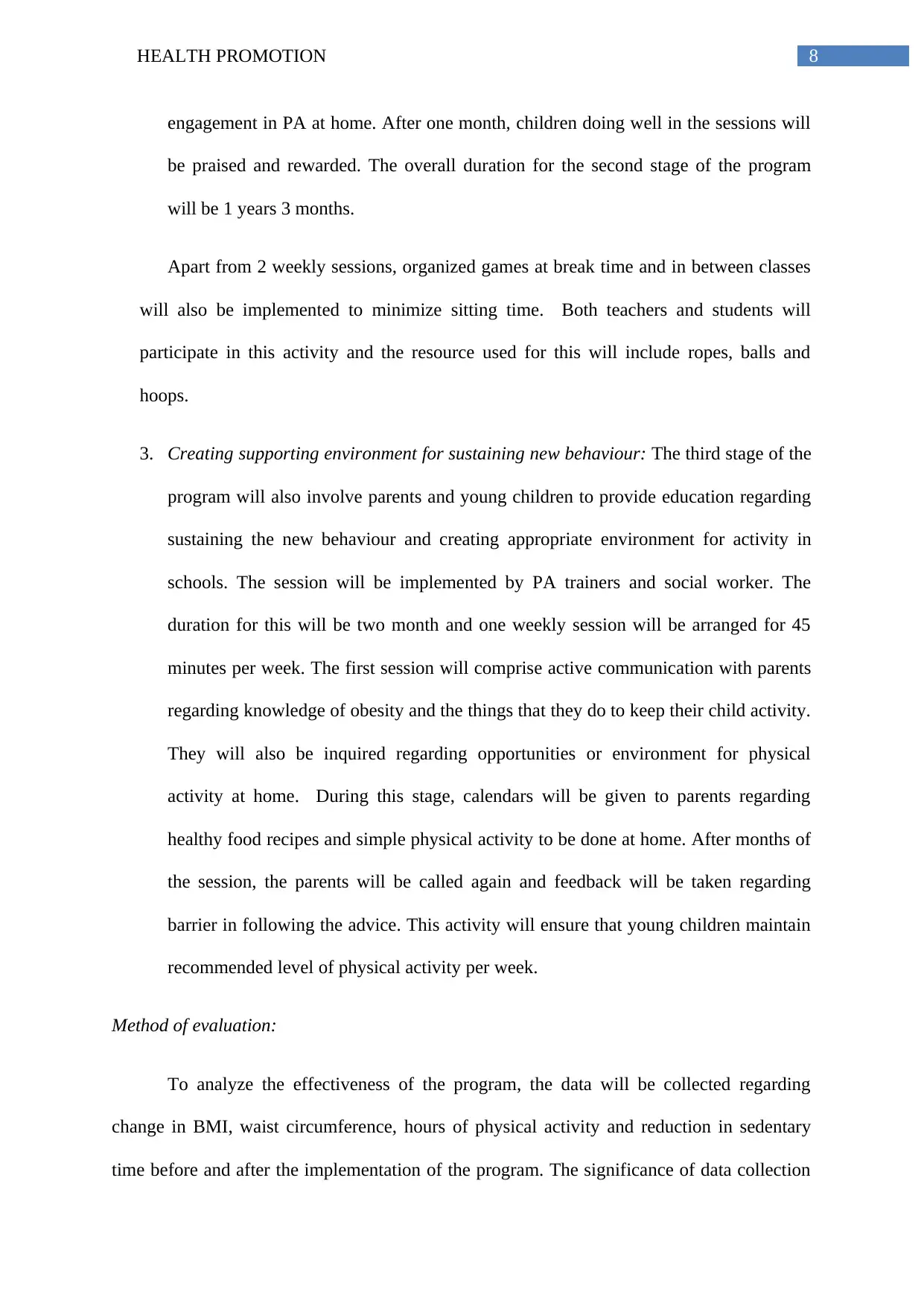
8HEALTH PROMOTION
engagement in PA at home. After one month, children doing well in the sessions will
be praised and rewarded. The overall duration for the second stage of the program
will be 1 years 3 months.
Apart from 2 weekly sessions, organized games at break time and in between classes
will also be implemented to minimize sitting time. Both teachers and students will
participate in this activity and the resource used for this will include ropes, balls and
hoops.
3. Creating supporting environment for sustaining new behaviour: The third stage of the
program will also involve parents and young children to provide education regarding
sustaining the new behaviour and creating appropriate environment for activity in
schools. The session will be implemented by PA trainers and social worker. The
duration for this will be two month and one weekly session will be arranged for 45
minutes per week. The first session will comprise active communication with parents
regarding knowledge of obesity and the things that they do to keep their child activity.
They will also be inquired regarding opportunities or environment for physical
activity at home. During this stage, calendars will be given to parents regarding
healthy food recipes and simple physical activity to be done at home. After months of
the session, the parents will be called again and feedback will be taken regarding
barrier in following the advice. This activity will ensure that young children maintain
recommended level of physical activity per week.
Method of evaluation:
To analyze the effectiveness of the program, the data will be collected regarding
change in BMI, waist circumference, hours of physical activity and reduction in sedentary
time before and after the implementation of the program. The significance of data collection
engagement in PA at home. After one month, children doing well in the sessions will
be praised and rewarded. The overall duration for the second stage of the program
will be 1 years 3 months.
Apart from 2 weekly sessions, organized games at break time and in between classes
will also be implemented to minimize sitting time. Both teachers and students will
participate in this activity and the resource used for this will include ropes, balls and
hoops.
3. Creating supporting environment for sustaining new behaviour: The third stage of the
program will also involve parents and young children to provide education regarding
sustaining the new behaviour and creating appropriate environment for activity in
schools. The session will be implemented by PA trainers and social worker. The
duration for this will be two month and one weekly session will be arranged for 45
minutes per week. The first session will comprise active communication with parents
regarding knowledge of obesity and the things that they do to keep their child activity.
They will also be inquired regarding opportunities or environment for physical
activity at home. During this stage, calendars will be given to parents regarding
healthy food recipes and simple physical activity to be done at home. After months of
the session, the parents will be called again and feedback will be taken regarding
barrier in following the advice. This activity will ensure that young children maintain
recommended level of physical activity per week.
Method of evaluation:
To analyze the effectiveness of the program, the data will be collected regarding
change in BMI, waist circumference, hours of physical activity and reduction in sedentary
time before and after the implementation of the program. The significance of data collection
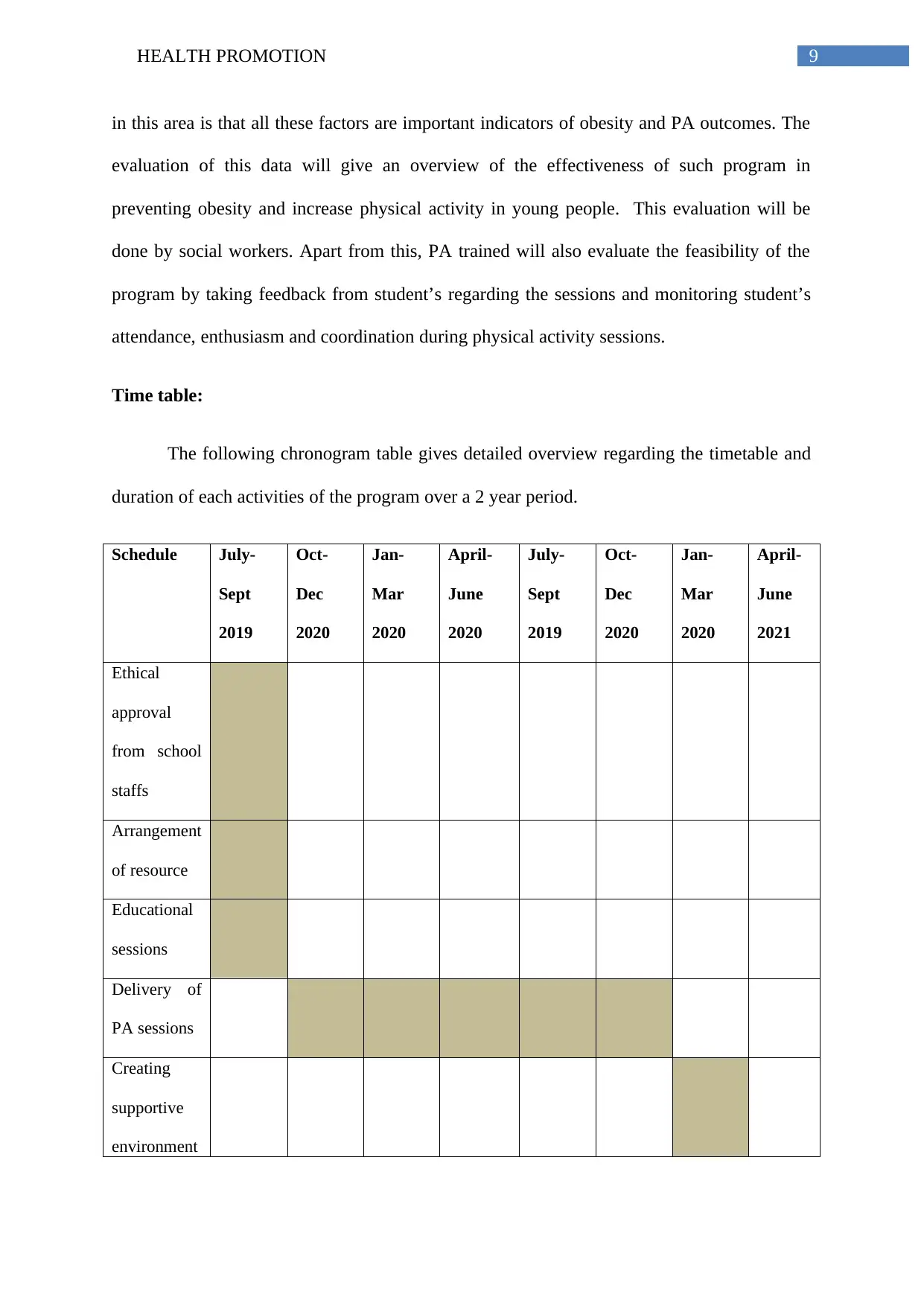
9HEALTH PROMOTION
in this area is that all these factors are important indicators of obesity and PA outcomes. The
evaluation of this data will give an overview of the effectiveness of such program in
preventing obesity and increase physical activity in young people. This evaluation will be
done by social workers. Apart from this, PA trained will also evaluate the feasibility of the
program by taking feedback from student’s regarding the sessions and monitoring student’s
attendance, enthusiasm and coordination during physical activity sessions.
Time table:
The following chronogram table gives detailed overview regarding the timetable and
duration of each activities of the program over a 2 year period.
Schedule July-
Sept
2019
Oct-
Dec
2020
Jan-
Mar
2020
April-
June
2020
July-
Sept
2019
Oct-
Dec
2020
Jan-
Mar
2020
April-
June
2021
Ethical
approval
from school
staffs
Arrangement
of resource
Educational
sessions
Delivery of
PA sessions
Creating
supportive
environment
in this area is that all these factors are important indicators of obesity and PA outcomes. The
evaluation of this data will give an overview of the effectiveness of such program in
preventing obesity and increase physical activity in young people. This evaluation will be
done by social workers. Apart from this, PA trained will also evaluate the feasibility of the
program by taking feedback from student’s regarding the sessions and monitoring student’s
attendance, enthusiasm and coordination during physical activity sessions.
Time table:
The following chronogram table gives detailed overview regarding the timetable and
duration of each activities of the program over a 2 year period.
Schedule July-
Sept
2019
Oct-
Dec
2020
Jan-
Mar
2020
April-
June
2020
July-
Sept
2019
Oct-
Dec
2020
Jan-
Mar
2020
April-
June
2021
Ethical
approval
from school
staffs
Arrangement
of resource
Educational
sessions
Delivery of
PA sessions
Creating
supportive
environment
Secure Best Marks with AI Grader
Need help grading? Try our AI Grader for instant feedback on your assignments.
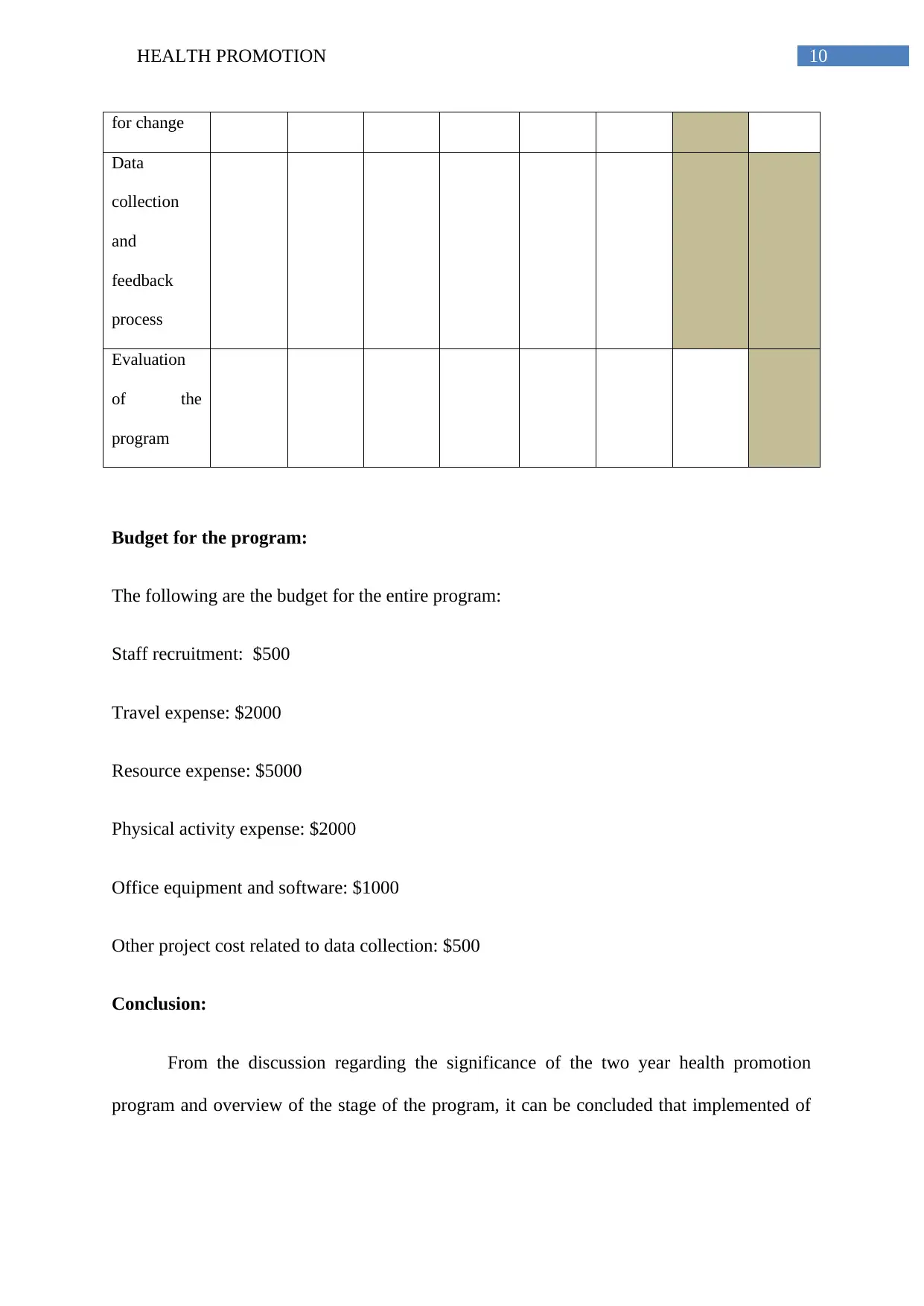
10HEALTH PROMOTION
for change
Data
collection
and
feedback
process
Evaluation
of the
program
Budget for the program:
The following are the budget for the entire program:
Staff recruitment: $500
Travel expense: $2000
Resource expense: $5000
Physical activity expense: $2000
Office equipment and software: $1000
Other project cost related to data collection: $500
Conclusion:
From the discussion regarding the significance of the two year health promotion
program and overview of the stage of the program, it can be concluded that implemented of
for change
Data
collection
and
feedback
process
Evaluation
of the
program
Budget for the program:
The following are the budget for the entire program:
Staff recruitment: $500
Travel expense: $2000
Resource expense: $5000
Physical activity expense: $2000
Office equipment and software: $1000
Other project cost related to data collection: $500
Conclusion:
From the discussion regarding the significance of the two year health promotion
program and overview of the stage of the program, it can be concluded that implemented of
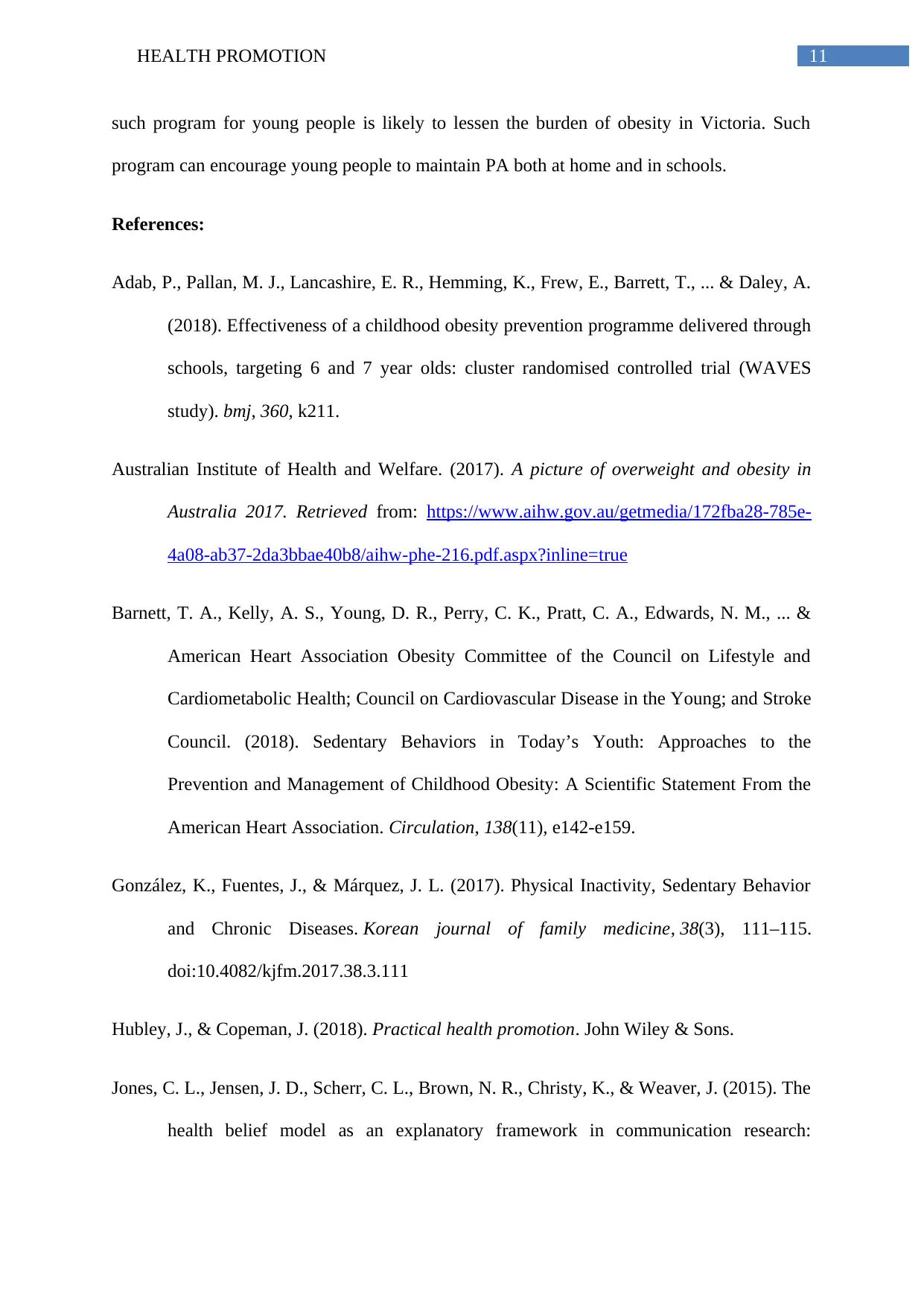
11HEALTH PROMOTION
such program for young people is likely to lessen the burden of obesity in Victoria. Such
program can encourage young people to maintain PA both at home and in schools.
References:
Adab, P., Pallan, M. J., Lancashire, E. R., Hemming, K., Frew, E., Barrett, T., ... & Daley, A.
(2018). Effectiveness of a childhood obesity prevention programme delivered through
schools, targeting 6 and 7 year olds: cluster randomised controlled trial (WAVES
study). bmj, 360, k211.
Australian Institute of Health and Welfare. (2017). A picture of overweight and obesity in
Australia 2017. Retrieved from: https://www.aihw.gov.au/getmedia/172fba28-785e-
4a08-ab37-2da3bbae40b8/aihw-phe-216.pdf.aspx?inline=true
Barnett, T. A., Kelly, A. S., Young, D. R., Perry, C. K., Pratt, C. A., Edwards, N. M., ... &
American Heart Association Obesity Committee of the Council on Lifestyle and
Cardiometabolic Health; Council on Cardiovascular Disease in the Young; and Stroke
Council. (2018). Sedentary Behaviors in Today’s Youth: Approaches to the
Prevention and Management of Childhood Obesity: A Scientific Statement From the
American Heart Association. Circulation, 138(11), e142-e159.
González, K., Fuentes, J., & Márquez, J. L. (2017). Physical Inactivity, Sedentary Behavior
and Chronic Diseases. Korean journal of family medicine, 38(3), 111–115.
doi:10.4082/kjfm.2017.38.3.111
Hubley, J., & Copeman, J. (2018). Practical health promotion. John Wiley & Sons.
Jones, C. L., Jensen, J. D., Scherr, C. L., Brown, N. R., Christy, K., & Weaver, J. (2015). The
health belief model as an explanatory framework in communication research:
such program for young people is likely to lessen the burden of obesity in Victoria. Such
program can encourage young people to maintain PA both at home and in schools.
References:
Adab, P., Pallan, M. J., Lancashire, E. R., Hemming, K., Frew, E., Barrett, T., ... & Daley, A.
(2018). Effectiveness of a childhood obesity prevention programme delivered through
schools, targeting 6 and 7 year olds: cluster randomised controlled trial (WAVES
study). bmj, 360, k211.
Australian Institute of Health and Welfare. (2017). A picture of overweight and obesity in
Australia 2017. Retrieved from: https://www.aihw.gov.au/getmedia/172fba28-785e-
4a08-ab37-2da3bbae40b8/aihw-phe-216.pdf.aspx?inline=true
Barnett, T. A., Kelly, A. S., Young, D. R., Perry, C. K., Pratt, C. A., Edwards, N. M., ... &
American Heart Association Obesity Committee of the Council on Lifestyle and
Cardiometabolic Health; Council on Cardiovascular Disease in the Young; and Stroke
Council. (2018). Sedentary Behaviors in Today’s Youth: Approaches to the
Prevention and Management of Childhood Obesity: A Scientific Statement From the
American Heart Association. Circulation, 138(11), e142-e159.
González, K., Fuentes, J., & Márquez, J. L. (2017). Physical Inactivity, Sedentary Behavior
and Chronic Diseases. Korean journal of family medicine, 38(3), 111–115.
doi:10.4082/kjfm.2017.38.3.111
Hubley, J., & Copeman, J. (2018). Practical health promotion. John Wiley & Sons.
Jones, C. L., Jensen, J. D., Scherr, C. L., Brown, N. R., Christy, K., & Weaver, J. (2015). The
health belief model as an explanatory framework in communication research:
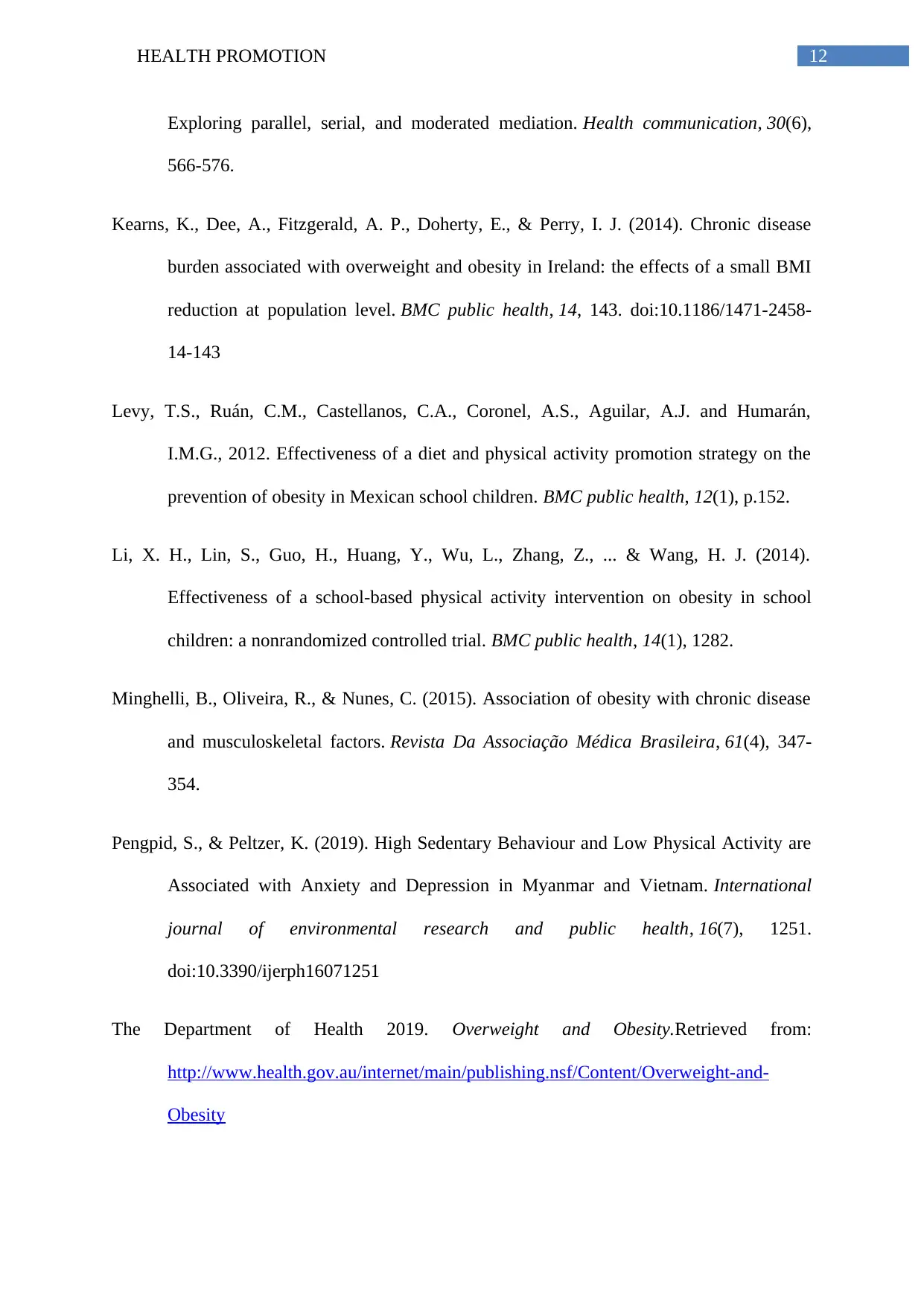
12HEALTH PROMOTION
Exploring parallel, serial, and moderated mediation. Health communication, 30(6),
566-576.
Kearns, K., Dee, A., Fitzgerald, A. P., Doherty, E., & Perry, I. J. (2014). Chronic disease
burden associated with overweight and obesity in Ireland: the effects of a small BMI
reduction at population level. BMC public health, 14, 143. doi:10.1186/1471-2458-
14-143
Levy, T.S., Ruán, C.M., Castellanos, C.A., Coronel, A.S., Aguilar, A.J. and Humarán,
I.M.G., 2012. Effectiveness of a diet and physical activity promotion strategy on the
prevention of obesity in Mexican school children. BMC public health, 12(1), p.152.
Li, X. H., Lin, S., Guo, H., Huang, Y., Wu, L., Zhang, Z., ... & Wang, H. J. (2014).
Effectiveness of a school-based physical activity intervention on obesity in school
children: a nonrandomized controlled trial. BMC public health, 14(1), 1282.
Minghelli, B., Oliveira, R., & Nunes, C. (2015). Association of obesity with chronic disease
and musculoskeletal factors. Revista Da Associação Médica Brasileira, 61(4), 347-
354.
Pengpid, S., & Peltzer, K. (2019). High Sedentary Behaviour and Low Physical Activity are
Associated with Anxiety and Depression in Myanmar and Vietnam. International
journal of environmental research and public health, 16(7), 1251.
doi:10.3390/ijerph16071251
The Department of Health 2019. Overweight and Obesity.Retrieved from:
http://www.health.gov.au/internet/main/publishing.nsf/Content/Overweight-and-
Obesity
Exploring parallel, serial, and moderated mediation. Health communication, 30(6),
566-576.
Kearns, K., Dee, A., Fitzgerald, A. P., Doherty, E., & Perry, I. J. (2014). Chronic disease
burden associated with overweight and obesity in Ireland: the effects of a small BMI
reduction at population level. BMC public health, 14, 143. doi:10.1186/1471-2458-
14-143
Levy, T.S., Ruán, C.M., Castellanos, C.A., Coronel, A.S., Aguilar, A.J. and Humarán,
I.M.G., 2012. Effectiveness of a diet and physical activity promotion strategy on the
prevention of obesity in Mexican school children. BMC public health, 12(1), p.152.
Li, X. H., Lin, S., Guo, H., Huang, Y., Wu, L., Zhang, Z., ... & Wang, H. J. (2014).
Effectiveness of a school-based physical activity intervention on obesity in school
children: a nonrandomized controlled trial. BMC public health, 14(1), 1282.
Minghelli, B., Oliveira, R., & Nunes, C. (2015). Association of obesity with chronic disease
and musculoskeletal factors. Revista Da Associação Médica Brasileira, 61(4), 347-
354.
Pengpid, S., & Peltzer, K. (2019). High Sedentary Behaviour and Low Physical Activity are
Associated with Anxiety and Depression in Myanmar and Vietnam. International
journal of environmental research and public health, 16(7), 1251.
doi:10.3390/ijerph16071251
The Department of Health 2019. Overweight and Obesity.Retrieved from:
http://www.health.gov.au/internet/main/publishing.nsf/Content/Overweight-and-
Obesity
Paraphrase This Document
Need a fresh take? Get an instant paraphrase of this document with our AI Paraphraser

13HEALTH PROMOTION
Victoria State Government (2019). Department of Health and Human Services strategic plan.
Retrieved from: https://dhhs.vic.gov.au/publications/department-health-and-human-
services-strategic-plan
Wijlaars, L. P., Gilbert, R., & Hardelid, P. (2016). Chronic conditions in children and young
people: learning from administrative data. Archives of disease in childhood, 101(10),
881-885.
Victoria State Government (2019). Department of Health and Human Services strategic plan.
Retrieved from: https://dhhs.vic.gov.au/publications/department-health-and-human-
services-strategic-plan
Wijlaars, L. P., Gilbert, R., & Hardelid, P. (2016). Chronic conditions in children and young
people: learning from administrative data. Archives of disease in childhood, 101(10),
881-885.

14HEALTH PROMOTION
1 out of 15
Related Documents
Your All-in-One AI-Powered Toolkit for Academic Success.
+13062052269
info@desklib.com
Available 24*7 on WhatsApp / Email
![[object Object]](/_next/static/media/star-bottom.7253800d.svg)
Unlock your academic potential
© 2024 | Zucol Services PVT LTD | All rights reserved.





